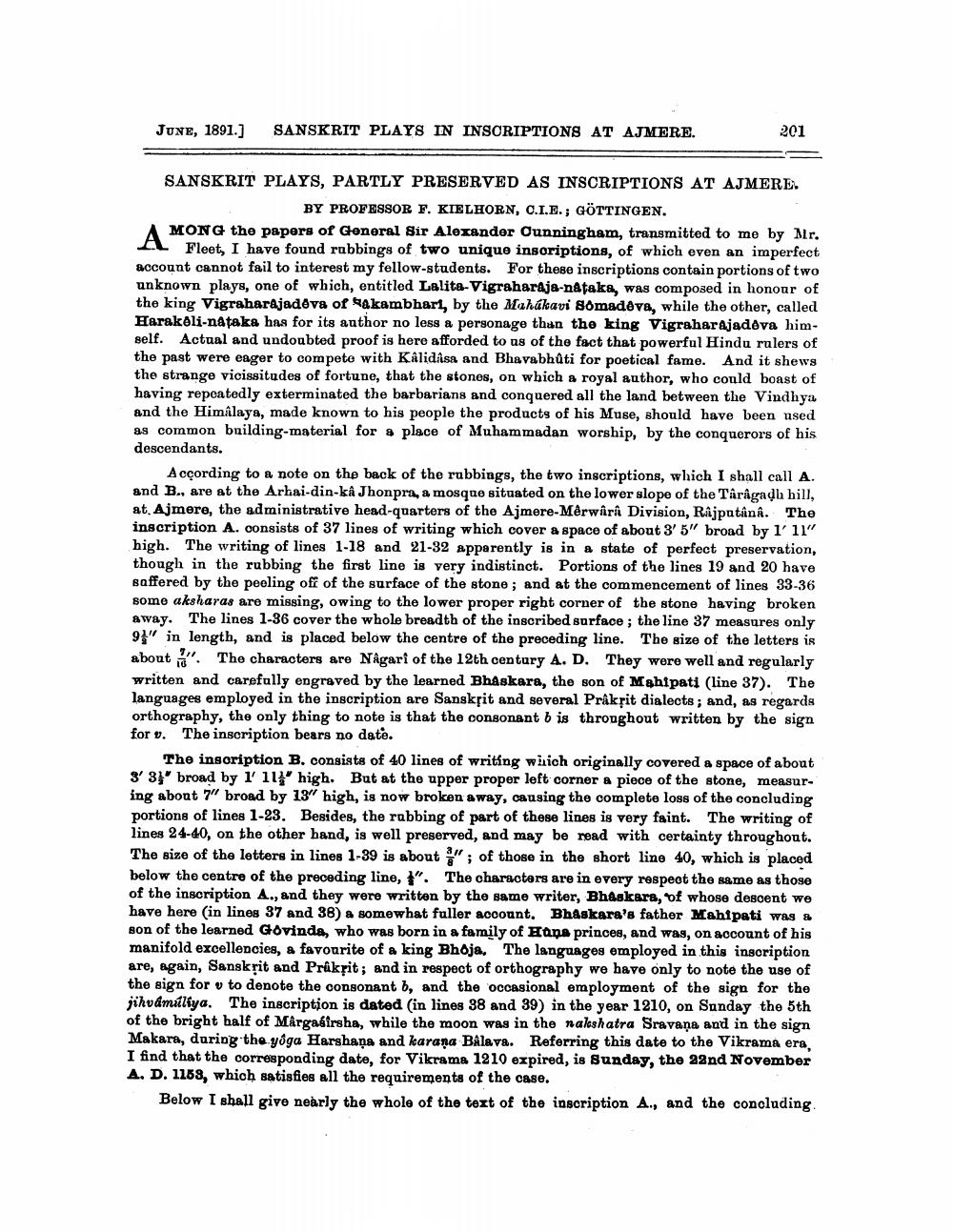________________
JUNE, 1891.] SANSKRIT PLAYS IN INSCRIPTIONS AT AJMERE.
201
SANSKRIT PLAYS, PARTLY PRESERVED AS INSCRIPTIONS AT AJMERE.
BY PROFESSOR F. KIELHORN, C.I.E.; GÖTTINGEN.
A
MONG the papers of General Sir Alexander Cunningham, transmitted to me by Mr. Fleet, I have found rubbings of two unique insoriptions, of which even an imperfect account cannot fail to interest my fellow-students. For these inscriptions contain portions of two unknown plays, one of which, entitled Lalita-Vigraharaja-nataka, was composed in honour of the king Vigraharajadeva of akambhari, by the Mahakavi Somadeva, while the other, called Harakoli-nataka has for its author no less a personage than the king Vigraharajadeva himself. Actual and undoubted proof is here afforded to us of the fact that powerful Hindu rulers of the past were eager to compete with Kâlidâsa and Bhavabhuti for poetical fame. And it shews the strange vicissitudes of fortune, that the stones, on which a royal author, who could boast of having repeatedly exterminated the barbarians and conquered all the land between the Vindhya and the Himalaya, made known to his people the products of his Muse, should have been used as common building-material for a place of Muhammadan worship, by the conquerors of his descendants.
According to a note on the back of the rubbings, the two inscriptions, which I shall call A. and B., are at the Arhai-din-kâ Jhonpra, a mosque situated on the lower slope of the Târâgadh hill, at. Ajmere, the administrative head-quarters of the Ajmere-Mêrwârâ Division, Rajputânâ. The inscription A. consists of 37 lines of writing which cover a space of about 3' 5" broad by 1' 11" high. The writing of lines 1-18 and 21-32 apparently is in a state of perfect preservation, though in the rubbing the first line is very indistinct. Portions of the lines 19 and 20 have saffered by the peeling off of the surface of the stone; and at the commencement of lines 33-36 some aksharas are missing, owing to the lower proper right corner of the stone having broken away. The lines 1-36 cover the whole breadth of the inscribed surface; the line 37 measures only 9" in length, and is placed below the centre of the preceding line. The size of the letters is about. The characters are Nagari of the 12th century A. D. They were well and regularly written and carefully engraved by the learned Bhaskara, the son of Mahipati (line 37). The languages employed in the inscription are Sanskrit and several Prakrit dialects; and, as regards orthography, the only thing to note is that the consonant b is throughout written by the sign for v. The inscription bears no date.
The inscription B. consists of 40 lines of writing which originally covered a space of about 3' 3 broad by 1' 11" high. But at the upper proper left corner a piece of the stone, measuring about 7" broad by 13" high, is now broken away, causing the complete loss of the concluding portions of lines 1-23. Besides, the rubbing of part of these lines is very faint. The writing of lines 24-40, on the other hand, is well preserved, and may be read with certainty throughout. The size of the letters in lines 1-39 is about "; of those in the short line 40, which is placed below the centre of the preceding line, ". The characters are in every respect the same as those of the inscription A., and they were written by the same writer, Bhaskara, of whose descent we have here (in lines 37 and 38) a somewhat fuller account. Bhaskara's father Mahipati was a son of the learned Govinda, who was born in a family of Hana princes, and was, on account of his manifold excellencies, a favourite of a king Bhoja, The languages employed in this inscription are, again, Sanskrit and Prakrit; and in respect of orthography we have only to note the use of the sign for v to denote the consonant b, and the occasional employment of the sign for the jihvamaliya. The inscription is dated (in lines 38 and 39) in the year 1210, on Sunday the 5th of the bright half of Mârgaáirsha, while the moon was in the nakshatra Sravana and in the sign Makara, during the yoga Harshana and karana Bâlava. Referring this date to the Vikrama era, I find that the corresponding date, for Vikrama 1210 expired, is Sunday, the 22nd November A. D. 1158, which satisfies all the requirements of the case.
Below I shall give nearly the whole of the text of the inscription A., and the concluding.




